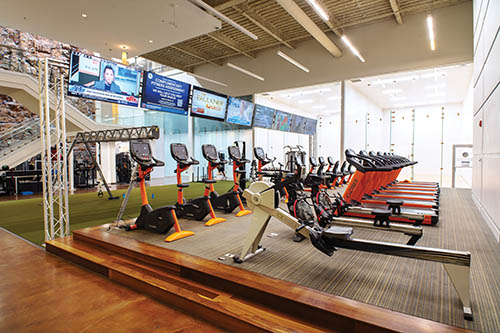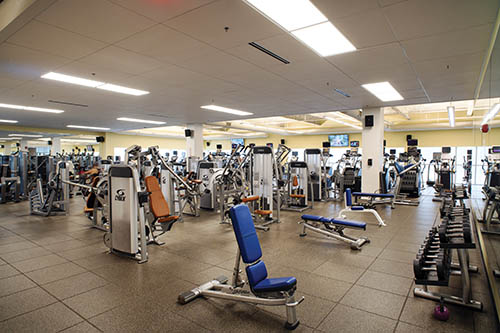— By Norm Pensky —
How gyms can reduce costs and embrace sustainability.
Today’s fitness market is increasingly competitive, with boutique workout classes and home exercise options pulling customers in new directions. Instead of chasing costly trends, gym owners can reduce costs and improve profitability by optimizing what’s within their control: energy efficiency. While high-end equipment and lavish amenities may attract attention, smarter energy management offers a more sustainable way to succeed in this crowded industry.

Running a gym is energy-intensive. Climate control, lighting and equipment drive up electricity and water consumption, with some estimates suggesting fitness centers spend nearly $70,000 annually on utilities — with even higher costs for 24/7 facilities. This figure is projected to increase in 2025 as costs continue to rise, with the EIA signaling a 7% increase from 2024 to an average wholesale power price of $40 per megawatt-hour (MWh) in 2025. Outdated and inefficient energy infrastructure strains profit margins, limiting a gym’s ability to offer competitive memberships. This makes energy efficiency an essential lever for owners in driving cost reductions.
While a gym’s energy costs may not immediately influence most members’ decisions, they contribute to rising membership fees. In recent years, high inflation has pressured gym budgets, often leading to price increases. By proactively reducing energy expenses, gyms can stabilize rates, helping retain members.
Another factor top of mind for customers is sustainability. A 2024 YouGov survey found that two-thirds of gym-goers consider a facility’s environmental impact when choosing where to work out. This figure rises above 70% for the 18-34 demographic. By adopting sustainability initiatives, gyms can appeal to this growing market, fostering long term brand loyalty.
Energy-efficient gyms also enhance the customer experience and are essential for maintaining a healthy facility. Outdated HVAC systems, for instance, can recirculate pollutants, compromising air quality and athletic performance. Replacing aging HVAC can take months, frustrating members and increasing the risk of cancellations. Gymgoers rightly expect proper heating, cooling and lighting — especially in a space where they’re in close contact with dozens of others breathing and sweating heavily.
Here are specific technologies gyms can deploy to improve energy management:
• Modernized HVAC: Climate control is essential for gym comfort, but traditional HVAC systems often waste energy. Smart HVAC systems adjust temperature and ventilation dynamically based on occupancy and outdoor conditions. In addition to improving energy efficiency, these systems enhance air quality, an essential factor in athletic performance and member retention, as mentioned above.
• Water Management: Water consumption is another primary consideration for gyms, particularly in showers, restrooms and locker rooms. Installing high-efficiency fixtures, such as low-flow showers and sensor-based faucets, can significantly reduce waste, which is critical for cutting water bills and overall sustainability measures.
• LED Lighting: Lighting upgrades offer another opportunity to boost efficiency. Traditional lighting systems consume excessive electricity and generate heat, increasing the burden on air conditioning. LED lighting, by contrast, uses up to 75% less energy, lasts significantly longer and reduces overheating — especially crucial during warmer months.
• Solar Energy: Installing solar panels can significantly cut long term energy costs while demonstrating a commitment to sustainability. Technological advances and decreasing manufacturing and installation costs have made it a viable option for many fitness centers. Additionally, gyms in states with net metering policies can sell excess energy back to the grid, creating an additional revenue stream.
• Software: Energy management software takes these efficiency efforts further by using sensors and automation to track real-time energy consumption. By analyzing gym occupancy patterns, these systems optimize lighting, HVAC and equipment usage, eliminating unnecessary energy waste. Smart monitoring tools provide gym owners with actionable insights to fine-tune operations. For example, if peak energy use occurs during specific hours, automated systems can adjust climate control settings accordingly.

The impact of these technologies extends beyond immediate energy savings and environmental benefits and sets gyms up for long term success. Modernized energy improvements provide financial stability, insulating gyms from fluctuating utility rates and enabling owners to reinvest savings into facility upgrades, new equipment or expanded services that attract and retain new members. Proactively adopting energy-efficient solutions also positions gyms to stay ahead of tightening regulations. Many cities like New York are implementing stricter energy use and air quality standards, and non-compliant facilities may face costly retrofits or penalties. Taking immediate action allows gym owners to future-proof their businesses while demonstrating leadership in sustainability.
Of course, recognizing the need for energy upgrades is one thing; implementing them is another. For many gyms, notably smaller independent ones, these improvements can seem financially and logistically daunting. However, partnering with energy management experts eliminates cost barriers through financing options or performance-based solutions that require little to no upfront investment. This levels the playing field, allowing smaller gyms to compete with larger chains while reinforcing their financial and sustainability positions.
Energy efficiency goes beyond cost savings, as it strengthens operations, enhances member satisfaction and attracts eco-conscious customers. By leveraging smart energy solutions and working with experienced partners, fitness centers can reduce expenses, navigate regulatory shifts and future-proof their business. As the fitness industry evolves, gyms that embrace energy efficiency will be best positioned to thrive in an increasingly competitive market.
— Norm Pensky is program director of Budderfly, a fast-growing Energy as a Service (EaaS) company and premier sustainability partner for businesses with repeatable footprints, such as restaurant chains, assisted living facilities, retail franchises and more. Budderfly installs, monitors and manages a combination of patented technologies, equipment upgrades and proprietary energy software for its customers at no out-of-pocket cost. Contact the author at https://www.budderfly.com/lets-talk/.

